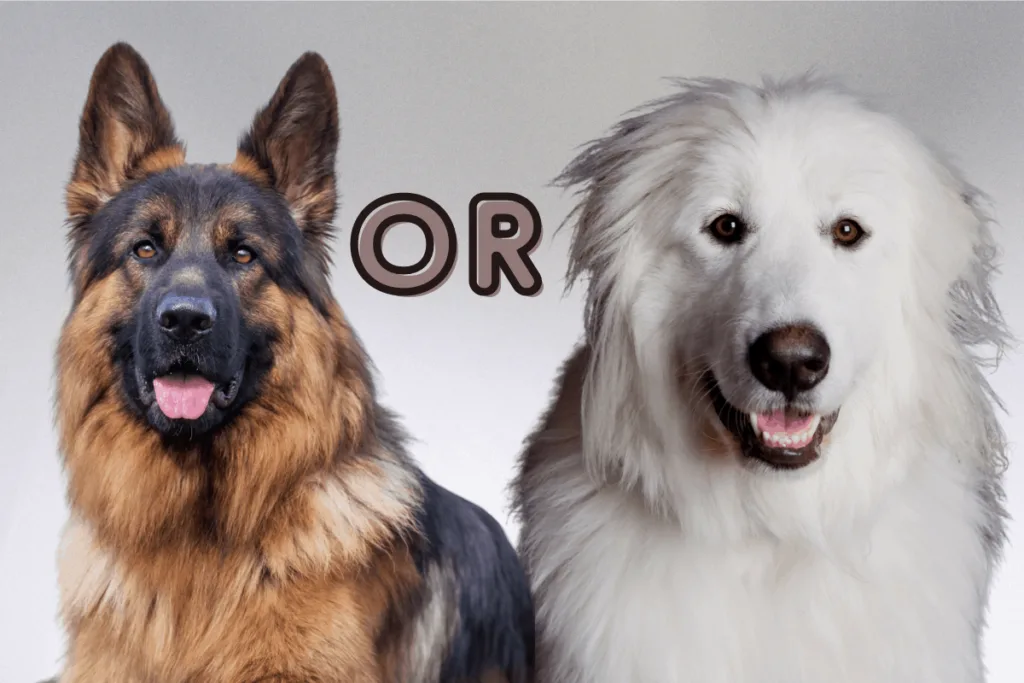
German Shepherds and Great Pyrenees are both wonderful dogs that pet owners everywhere enjoy and love dearly. Although, depending on a lot of different factors, one breed may make a better fit for your home compared to another. So what breed is best for you?
Some factors you should consider before getting a German Shepherd or Great Pyrenees include their overall care and training requirements. GSDs require less intensive overall care and are easy to train, making them good first dogs, while Great Pyrenees require more specialized care and training, making them a better fit for experienced dog owners.
In this article, we’ll be going in-depth into all the information you need to know about both of these breeds, as well as which dog will be the best fit for you.
If you’re interested in learning about these topics, keep on reading!
What’s Their Behavior Like?
One of the biggest factors that can contribute to whether this breed is a match for you is their behavior. How they behave around other dogs, as well as other animals and people, is a big factor that you should consider before bringing any new breed home.
Below, we’ll explore each of these breeds and what their behavior and personality are like in different situations.
The Behavior of a German Shepherd
German Shepherds are sweet dogs and known to be very protective and loyal to their owners and the homes they live in.
It’s important to be mindful of the fact that the protectiveness that German Shepherds possess can turn into aggression if they aren’t trained properly.
An untrained German Shepherd has the potential to pounce on or even attack a person or animal that they aren’t familiar with. While this breed isn’t mean or volatile, German Shepherds may simply believes that they are keeping their owners out of harm’s way.
It’s also important to note that German Shepherds are extremely obedient creatures, so training them won’t be as difficult as training other breeds.
These dogs also may come off as somewhat aloof and cautious in the beginning, but once you’ve earned their trust, you have a friend for life.
Another valuable note to make about a German Shepherd’s behavior is their bark. This breed is considered more vocal than others, and without proper training, can bark a lot.
Even with all the proper training, it’s important to be aware that this is a talkative breed.
For an in-depth look at German Shepherd aggression with all the specifics, we have an excellent article for you linked below:
German Shepherd Aggression: Why and What to Do About It
The Behavior of a Great Pyrenees
Great Pyrenees dogs are known to be a quite serious breed and have a very calm and steady personality. If you’re looking for a breed that’s more laid back and less playful, the Great Pyrenees may be right for you.
They are known to be very loyal and protective dogs, while also being quite independent and are known to do as they please.
Seeing how Great Pyrenees are very protective of their people and property, they are known to come off as aggressive, and therefore may have a hard time making new friends.
However, with the proper training, this breed is perfect for those who are looking for a sweet and laid back dog to own.
That being said, seeing how this breed is known to be quite independent, it can be difficult to train them. While not impossible, this is another factor to be mindful of before adopting a dog of this breed.
As for barking, this breed is also quite talkative and is prone to barking. While you can’t remove a Great Pyrenees’ instinct to bark often, there are ways to minimize this, including keeping them indoors at night and giving them plenty of opportunities to socialize with others.
Pros and Cons
| German Shepherd | Pros: loyal, protective, friendly, obedient, easy to train. | Cons: Can come off as aggressive, aloof, prone to barking |
| Great Pyrenees | Pros: calm, steady, protective, laid back. | Cons: Do as they please, difficult to train, prone to barking |
Are They Better for New or More Experienced Dog Owners?
Another factor to consider when bringing a new dog home is the level of care they’ll need in order to stay happy and healthy.
It’s important to note that some dogs are easier to care for than others, and are therefore easier for new dog owners to care for.
Below, we’ll explore the level of difficulty both of these breeds possess when it comes to the kind of care they require.
German Shepherds Are Great for First-Time Owners
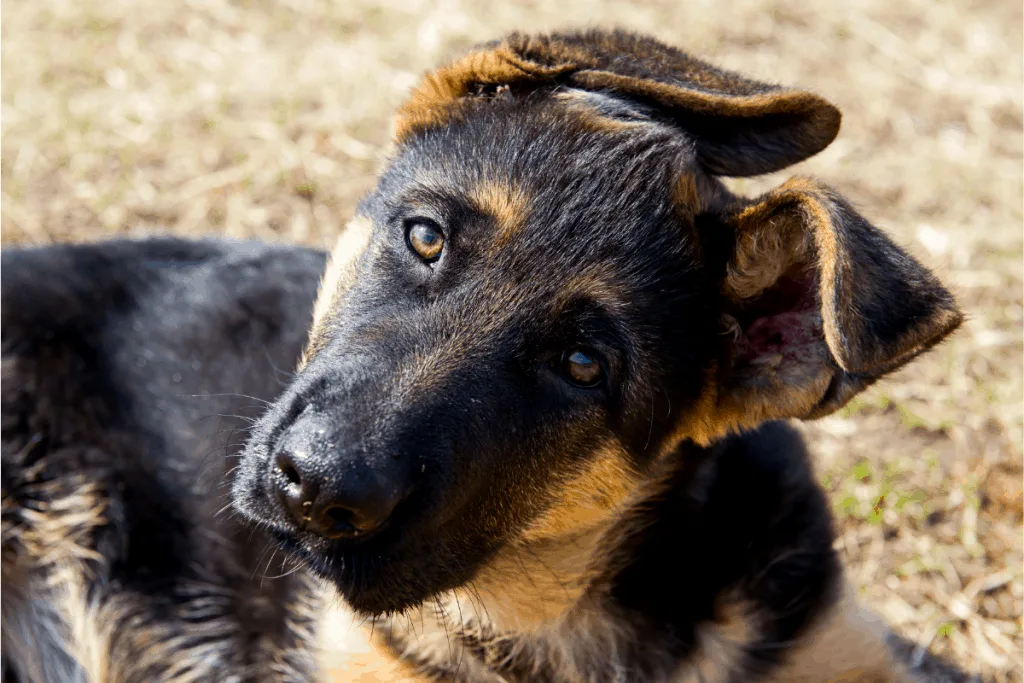
As we stated earlier, German Shepherds are very obedient dogs, making them ideal for new dog owners, given that they are fairly easy to train.
While training your German Shepherd still require a lot of your time and effort, they are a great choice for first-time dog owners.
This breed has a ‘will to please’ personality and is ideal for those embarking (no pun intended!) on dog ownership for the first time.
Your German Shepherd will love to follow your lead, which makes them easy to train, as well as easy for them to make new friends.
While this breed still requires lots of attention and thoughtful care, they are an easy pet to have, especially for inexperienced first-time owners.
Want to know all about German Shepherds and first-time dog ownership? Look no further – we’ve got you covered! Just take a look at the article linked below for all you need to know about GSDs and first-time dog ownership:
Are German Shepherds Good First Dogs? Prepare Yourself!
Great Pyrenees Are Great for More Experienced Owners
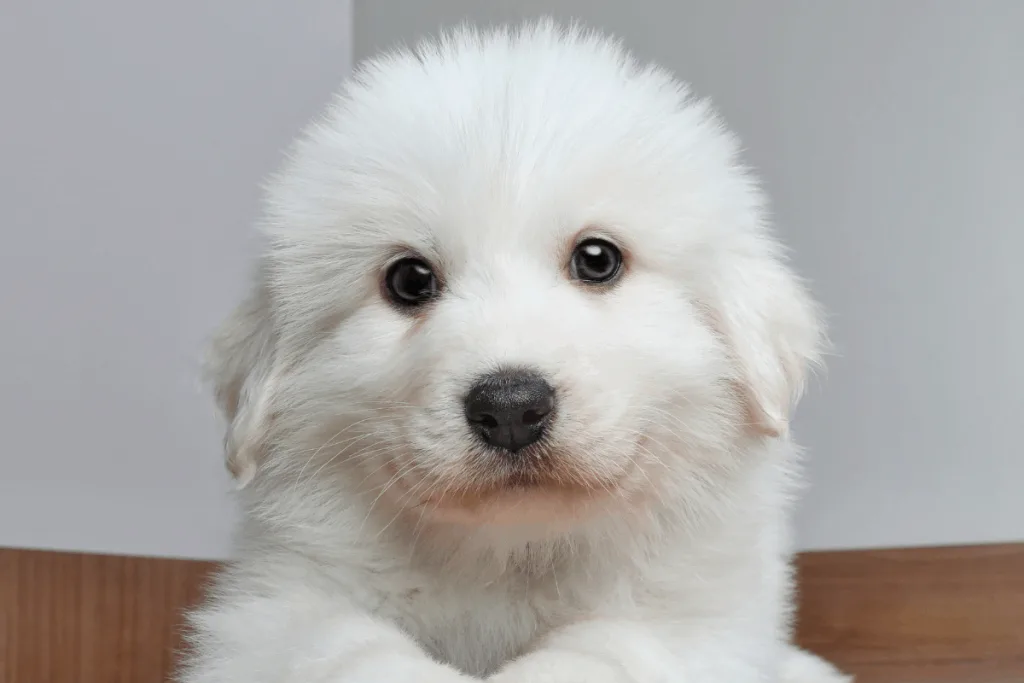
We mentioned earlier how this breed is prone to doing as they please and behaving independently, which may not make them the ideal candidates for first-time dog owners.
Great Pyrenees can be quite stubborn and difficult dogs to train, so this is something new pet owners should be aware of.
Taking care of this breed requires a bit more patience, time, and energy compared to other dogs, so it’s important to be mindful of this factor.
While other breeds aim to please and do good by their owners, you’ll have to earn your Great Pyrenees’ trust in order to have them abide by your rules.
Taking the time to understand what your dog responds to best will allow you understand them better and thus make for more productive training.
Pros and Cons
| German Shepherd | Pros: Great for first-time pet owners, they love to follow your lead and please you | Cons: Failure to train them early on can lead to behavioral problems |
| Great Pyrenees | Pros: Ideal for experienced pet owners | Cons: Can be stubborn and hard to train |
Are They Good Around Kids?
If you have kids at the house, one of the most important factors you’ll need to consider is whether that breed does well around children.
Factors such as size, temperament, and energy levels all play a role in whether a certain dog will make a safe addition to your house with your kids around.
Let’s now explore each of these breeds and how well they play and interact with kids of all ages.
German Shepherds Are Kid-Friendly
Because German Shepherds are very loyal and patient dogs, they make a great addition to any household with children.
While some may feel uncomfortable having their young children around such a large dog, German Shepherds that have been properly trained will become very protective and friendly towards any child.
It’s important that we note that a German Shepherd that has not been properly trained can become a risk when younger children are involved.
Properly socializing your German Shepherd early on will help them learn how to interact with people of all ages.
Your kids, as well as your German Shepherd, have plenty of energy and can safely interact and play with each other.
Ensuring that your dog is well trained and has experience meeting and interacting with kids of all ages will give your child a loyal and patient playmate for years to come.
For more information about properly socializing a German Shepherd and a more detailed look at how German Shepherds interact with children, you will want to take a look at the 2 articles we have for you linked below:
Great Pyrenees Are Kid-Friendly
We mentioned earlier how the Great Pyrenees is a very calm and well-behaved breed. This temperament makes these dogs perfect candidates for those who have children of any age.
This breed is very protective as well, making them ideal and safe playmates for young ones.
Similar to other breeds, it’s important that your Great Pyrenees is trained properly before interacting with children in order to keep everyone safe and out of harm’s way.
Once again, introducing your pup to socialization early on a big part of proper and effective training. Ensuring that your dog socializes with plenty of people, young and old, is key to your Great Pyrenees having a healthy and loving relationship with your child.
Pros and Cons
| German Shepherd | Pros: Friendly, playful protective of kids | Cons: Can be risky if dog isn’t trained properly |
| Great Pyrenees | Pros: Friendly, calm, protective of kids | Cons: Can be risky if dog isn’t trained properly |
Are They Good Apartment Dogs?
If you live in an apartment, the kind of dog you own is an important decision for you to consider.
Maybe your landlord has certain restrictions against specific breeds, or maybe you’re not looking to bring such a large, energetic dog into your small space.
Whatever the case may be, doing your research in terms of the best apartment dog for you is key to keeping you and your new pup happy and stress-free.
Below, we’ll explore whether these breeds can live comfortably inside an apartment.
German Shepherds Can Be Good Apartment Dogs
While Germans Shepherds are known to be quite large and energetic, this breed can comfortably live in an apartment as long as their basic needs are being met.
As we’ve discussed, German Shepherds can be easily trained, and they love to please their owners. Therefore, they can easily become apartment trained and live comfortably within any space.
Seeing how most apartments lack an enclosed backyard space, your German Shepherd will likely need walked for exercise and to do their business multiple times a day.
It’s also important to give your German Shepherd outdoor time for exercise and other activities, seeing how this breed will have a lot of energy to burn daily.
Providing your German Shepherd with the proper amount of outside time is crucial both for the sake of your dog and your apartment. If you don’t, it’s likely that your hyper pup will act out destructive behaviors and take it out on the belongings in your home.
We’ve extensively covered the topic of German Shepherd apartment living in the post linked below. In it you’ll find some considerations that many dog owners overlook when considering bringing a GSD into an apartment.
Can a German Shepherd Live in an Apartment?
Great Pyrenees Are Not Ideal Apartment Dogs
While this breed is quite calm and easy-going, a Great Pyrenees is not an ideal apartment dog due to the fact that they require a lot more space.
A Great Pyrenees will do much better in an environment that has a large enclosed space where they can roam around daily.
Similar to many other breeds, this dog requires lots of exercise and physical activity in order to stay healthy and strong, both physically and mentally.
This somewhat stubborn canine will also be hard to train and control within a much smaller space. Giving them the freedom to access an outdoor, enclosed space whenever they choose to is best for you and your Great Pyrenees pup.
Pros and Cons
| German Shepherd | Pros: Ideal for apartments, can live comfortably in any space with the proper training | Cons: Not giving them enough time outdoors leads to destructive behaviors |
| Great Pyrenees | Pros: Requires a large space | Cons: Not ideal for apartments, would be harder to train in a small space |
What Are Their Grooming Requirements?
Some breeds require more specific requirements when it comes to grooming. In order to keep your dog’s coat healthy, shiny, and free of dirt and oils, a certain level of grooming is required for every dog.
While some dogs have different kinds of coats that require a certain level of care, some breeds don’t require as much from their owner.
Below, we’ll look at each of these breed’s grooming requirements and whether it makes them easy or harder dogs to care for.
German Shepherd Grooming Requirements
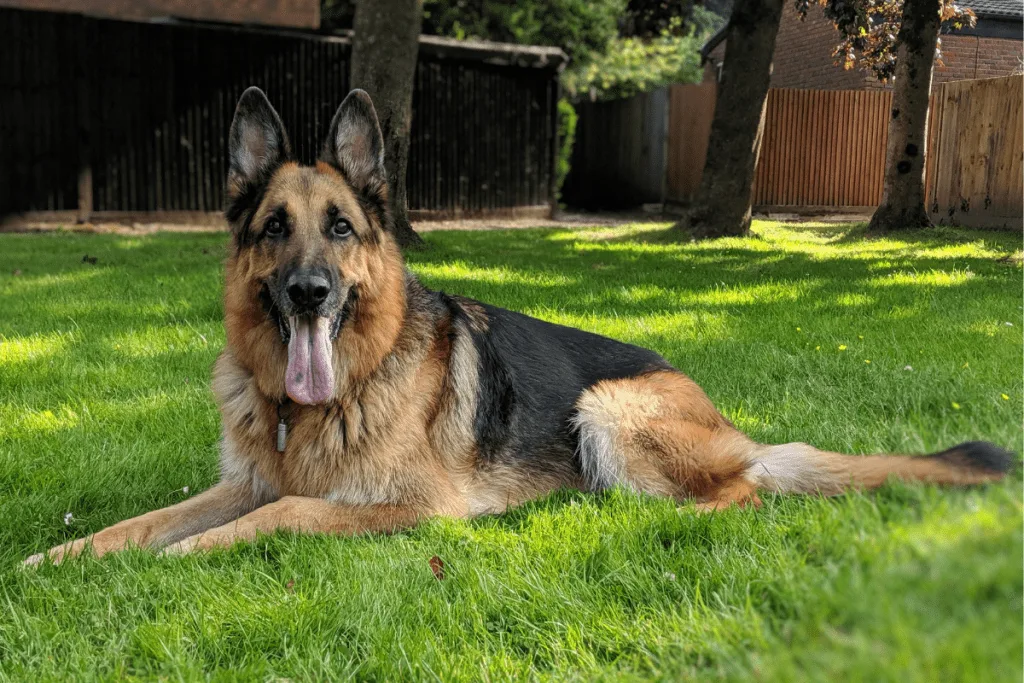
German Shepherds are aptly nicknamed “German Shedders,” so keep in mind that no matter how much you brush your GSD, you will still be left with plenty of hair in and around most of your belongings.
However, German Shepherds are fairly easy dogs to groom, as long as you keep up with it. Since this breed has a double coat, it’s vital that dog owners brush their canine 2-3 times a week.
This ensures that your dog’s coat stays healthy and shiny at all times, and it also reduces the amount hair that your GSD will shed all over the place.
Again, GSDs are known to be heavy shedders, so taking the time to brush and care for their fur is key to keeping everyone happy.
A routine nail inspection at least three times a month is ideal to ensure that your German Shepherd’s toenails are short enough.
Not keeping up with grooming requirements such as regular clippings and brushing can lead to problems down the line for your pup. Neglecting these things can result in skin problems, as well as matted and tangled coats.
For everything you need to know about grooming a German Shepherd, take a look at the article linked below. It provides comprehensive information on grooming a German Shepherd as well as the tools needed to properly do so:
Grooming a German Shepherd: All You Need to Know
Great Pyrenees Grooming Requirements
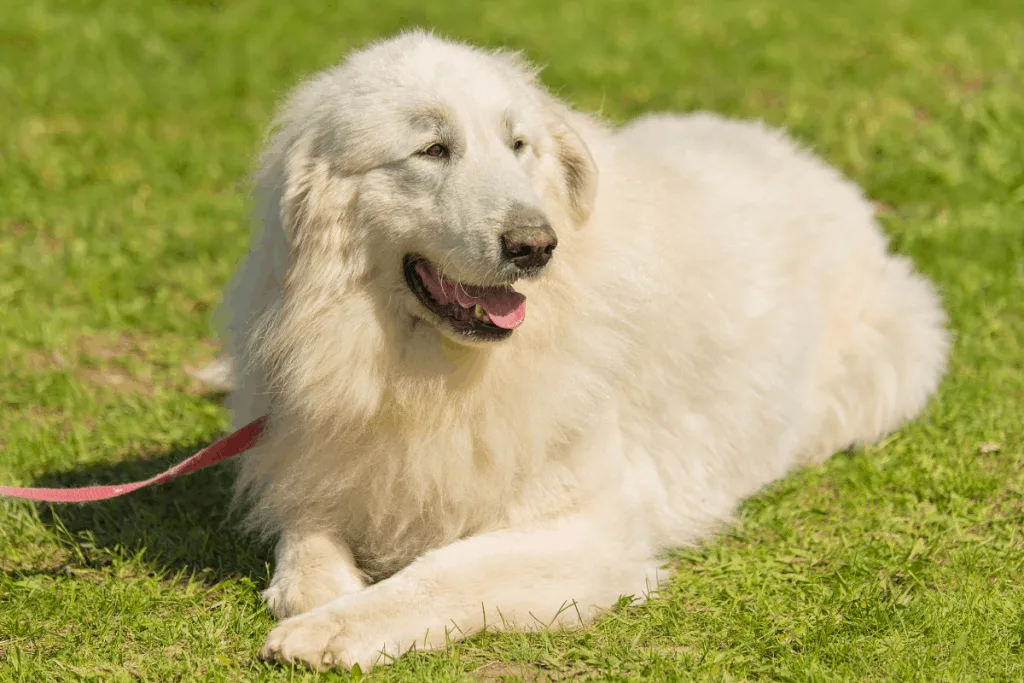
When it comes to the Great Pyrenees, they don’t require as much grooming as other breeds do. Giving your dog a good brushing once a week will do the job.
This breed is very easy to maintain, as they have a self-cleaning coat that keeps dirt and oils at bay. However, taking the time to clean your dog’s coat at least once a week is key to maintaining their coat and keeping it as healthy as possible.
It’s also important to keep up with the length of your a Great Pyrenees’ toenails in order to keep them comfortable.
Regular clippings are required to ensure that your Great Pyrenees always has enough clearance on the floor to walk on. Similar to other breeds, failure to properly groom this breed can result in damaged fur and skin.
Pros and Cons
| German Shepherd | Pros: Doesn’t require too much grooming | Cons: Failure to groom regularly can result in damaged skin and fur |
| Great Pyrenees | Pros: Doesn’t require too much grooming | Cons: Failure to groom regularly can result in damaged skin and fur |
What Size Are These Breeds?
Another important factor that may contribute to whether this breed is a good match for you is their size. While they may be cute and petite as puppies, some breeds can grow to be quite large.
It’s important that you take size considerations seriously, as keeping a large dog in an enclosed space can cause problems for both your dog and you if you are unaware of what you’re getting into.
The Size of a German Shepherd
German Shepherd adults can reach anywhere from 22-26 inches in height (55-65 cm), and around 75-96lbs (34-43kg). So if you’re looking for a large dog, a German Shepherd is definitely a great choice.
While some believe that this breed’s size makes them intimidating, the German Shepherd is just as kind-hearted as they are playful and will make a great addition to your own home.
Seeing how they’re such large dogs, they will have plenty of energy to burn throughout the day, making them an ideal pet for an active family. Activities such as hiking and running are the perfect compliment to a GSD’s energy levels.
The Size of a Great Pyrenees
Great Pyrenees adults can reach anywhere from 85-100 pounds (38-45kg) and are classified as giant dogs as opposed to large. Height wise, this breed can be anywhere from 25-32 inches (63-81 cm) tall.
While not as hyperactive as some other larger breeds, a Great Pyrenees is a great choice for those who are looking for a large dog that has a mellow personality.
This breed is also ideal for those who have access to a large space that your big dog can roam in daily.
Pros and Cons
| German Shepherd | Pros: Large dogs, best for an active family | Cons: Not an ideal breed for those who aren’t looking for a very large and energetic dog |
| Great Pyrenees | Pros: Giant dog, best for those who have a large space | Cons: Not ideal for those who aren’t looking for a very large dog |
Common Health Problems of This Breed
Another component you’ll want to consider before adopting is the health problems that certain breeds are susceptible to.
While this shouldn’t discourage you from owning a dog that may or may not suffer from certain health concerns, it’s important you’re educated beforehand so that you can give your furry friend the proper care they need.
Let’s now go in-depth into some of the common problems dog owners may see within certain breeds and what you should be on the lookout for.
Common Health Problems for German Shepherds
One of the most common problems German Shepherds come to face is hip dysplasia. This can be quite painful for your dog, as it’s a malformation in your dog’s hip that can be brought on by a lot of things.
While this health problem can be brought on by genetics, other factors such as overeating and over-exercising can cause your German Shepherd to suffer from hip dysplasia.
Epilepsy is also common within German Shepherds, so this is another factor to be mindful of. While there is no cure for epilepsy, with the right medication, your German Shepherd can live happily and comfortably even with a seizure disorder.
Another common health problem found in this breed is diabetes. Like many large breeds, German Shepherds have a habit of overeating if left unchecked. Thus, it is important to always closely monitor how much your GSD is eating.
Relatively, these dogs have a long life span, living anywhere from 9-13 years. As long as you introduce your pup to healthy habits early on, they are bound to live a long and happy life.
For a more detailed look at a few of the topics that we’ve just briefly covered in this section, you may find it useful to read over the articles linked below:
- How Long Do German Shepherds Live? A Detailed Guide
- German Shepherd Joint Problems: All You Need to Know
Common Health Problems for Great Pyrenees
A common health problem that your Great Pyrenees may face is osteochondrodysplasia – a developmental abnormality that affects your dog’s bone health and structure. This is a common problem amongst large dogs, so it’s key to be mindful of this.
Hip dysplasia is also common amongst this breed, as it’s a common health issue amongst larger dogs. Other joints can also be negatively affected in your Great Pyrenees, so it’s important to be mindful of this as well.
Great Pyrenees are also more susceptible to diseases in their eyelids and eyes, which may result in a need for surgery down the line.
As we stated earlier, none of these health problems are guaranteed to arise within your pet, but they are important to be watchful of if you own a dog of this specific breed.
Even if they experience some health problems throughout their life, a healthy Great Pyrenees will live up to 10-12 years. This is another reason that this breed makes a great family dog that will love you unconditionally for years to come.
Pros and Cons
| German Shepherd | Pros: Lives up to 12-14 years | Cons: Can deal with health problems such as hip dysplasia, epilepsy and diabetes |
| Great Pyrenees | Pros: Lives up to 10-12 years | Cons: Can deal with health problems such as osteochondrodysplasia, hip dysplasia and eye infections/diseases |
What’s Their Temperature Tolerance?
The last subject we’ll be exploring is each breed’s temperature tolerance. The ideal living environment for your pup all depends on what kind of climate they can endure.
While some dogs may do better in the cold, other dogs may not be accustomed to colder climates.
Below, we’ll explore how each breed does in certain kinds of climates, and where each of these dogs fit in, in terms of their ideal environment.
German Shepherd’s Temperature Tolerance
Seeing how most German Shepherds have a double coat, they can easily withstand colder climates easily. This breed will probably feel the most comfortable at temperatures around 45° to 85°F (7° to 29°C).
A healthy, adult German Shepherd can withstand temperatures as low as 20°F (-7°C). Anything colder than that, it’s recommended that your pup only experience those climates for a small amount of time, and ensuring that they are warmed afterwards.
If your German Shepherd doesn’t have a double coat, or perhaps they aren’t at their prime, it’s best to keep them away from temperatures that drop below 20°F (-7°C).
If your German Shepherd is unable to cope with the cold, their body language will be sure to tell you.
For more information on German Shepherd temperature tolerance as well as information about their coats, be sure to read over the 2 useful articles that we’ve provided for you below:
- What Temperatures Can German Shepherds Tolerate?
- Do German Shepherds Shed? All You Need to Know
- How to Read a German Shepherd’s Body Language
Great Pyrenees Temperature Tolerance
If you’re someone who lives in an area that gets extremely cold, a Great Pyrenees is a great choice for you. This breed can withstand temperatures ranging from 0° to 85°F (-18° to 20°C).
Great Pyrenees enjoy colder climates much more than they do warmer climates, and they thoroughly enjoy the snow. At the same time, they really do enjoy being indoors with their family.
While they can survive freezing temperatures, it’s important that your Great Pyrenees receives enough indoor warmth as well in order to stay healthy.
If you’re looking for the ideal breed to take hiking or skiing out in the snow, then this is the perfect dog for you. This active and colder climate-friendly dog will enjoy getting outdoors with you, no matter how chilly it is outside.
Pros and Cons
| German Shepherd | Pros: Can withstand temperatures between 45-85°F | Cons: Can’t withstand temperatures that are too cold |
| Great Pyrenees | Pros: Can withstand temperatures between 0-85°F | Cons: Can’t withstand temperatures that are too warm |
Cost of Owning a German Shepherd and Great Pyrenees
Last, but certainly not least, it is highly important to consider how much money owning each of these breeds will cost you.
While we would like to think that “we will make it work,” the reality is often sobering once you truly look at how much it costs to keep these breeds well-fed and properly cared for.
We’ll now take a look at the cost of ownership for each of these breeds.
Cost of Owning a German Shepherd
German Shepherds require a lot of high-quality food in their diet to maintain optimal health. What this means to you is that you may be spending just as much, if not more, on feeding your GSD as you would yourself or any member of your family.
The average cost of feeding a German Shepherd just dry food is roughly $80 per month for a high quality food. When you add in treats and other odds and ends, your final total will be closer to $100 per month.
Next, you need to figure in medical costs. Because they are prone to a host of health problems, German Shepherds require regular preventative veterinary visits.
On average, this will cost at least $400 per year. However, in the unfortunate event that your GSD does in fact have a serious health issue, this cost can easily rise to thousands of dollars.
Also, as with any dog, you need to take into consideration the costs of boarding, toys, a crate, bowls, and countless other accessories.
Much of these expenses will also come down to how much you like to spoil you dog. However, to many owners, dogs are like their children to them, so these expenses can really add up!
At minimum, owning a German Shepherd will cost you about $1,200 per year. At most – the sky is the limit here. I personally know GSD owners who spend well over $5,000 on their dogs every year!
Here are a few articles that will help you determine the true financial cost of owning a German Shepherd:
- German Shepherd Feeding Guide: All You Need to Know
- How Much Does a German Shepherd Puppy Cost?
- The Best Toys for German Shepherd Puppies and Adults
Cost of Owning a Great Pyrenees
Simply put, owning a Great Pyrenees will cost more than owning a German Shepherd.
This is because, since Great Pyrenees are significantly larger than GSDs, everything with them needs to be “supersized,” so to speak.
Consider the following:
- You will need to buy a larger crate
- You will need to buy more food
- You will need to buy larger toys
- You will need to buy a large dog bed
- You will need to spend more for grooming
Generally speaking, the larger and more durable a dog product is, the more it will cost.
While both of these breeds will set you back financially much more than a smaller breed of dog, it may be important for you to consider if you are willing to devote extensive financial resources towards the care required to give either of these breeds the happy and healthy lives they deserve.
Final Thoughts
In this article, we discussed many different factors you should consider before bringing either a Great Pyrenees or German Shepherd into your home.
Factors such as whether a certain breed is good around kids, ideal for small apartments, as well as what temperatures they can tolerate are just some of the considerations you should address before bringing home a new pup.
While both of these dogs will clearly make friendly and loving life long companions, it’s important to choose a breed that will suit your lifestyle as well as a breed that you can properly provide for.
Now you have all the information you need to make the right choice for you and your family as well as your future furry friend!
